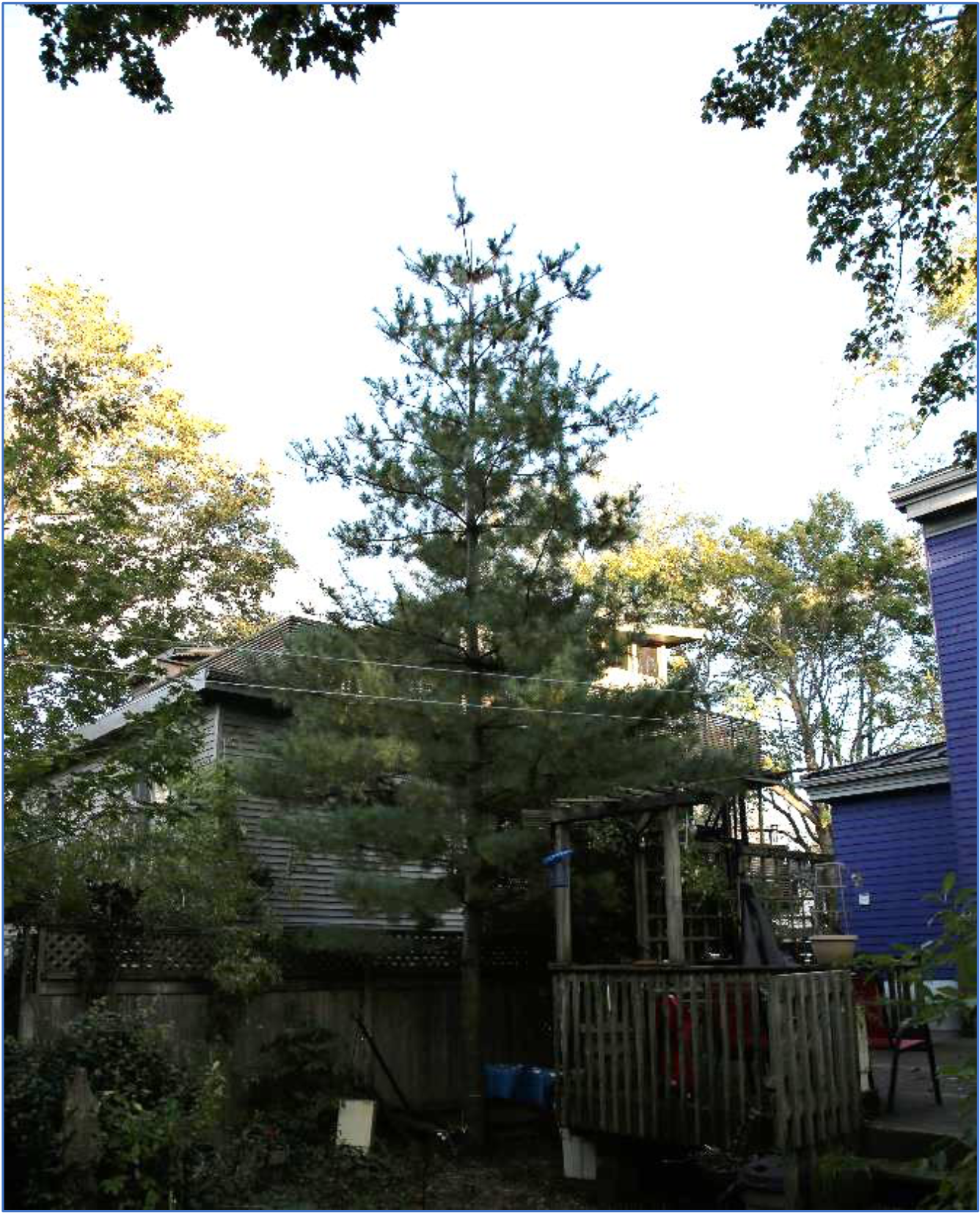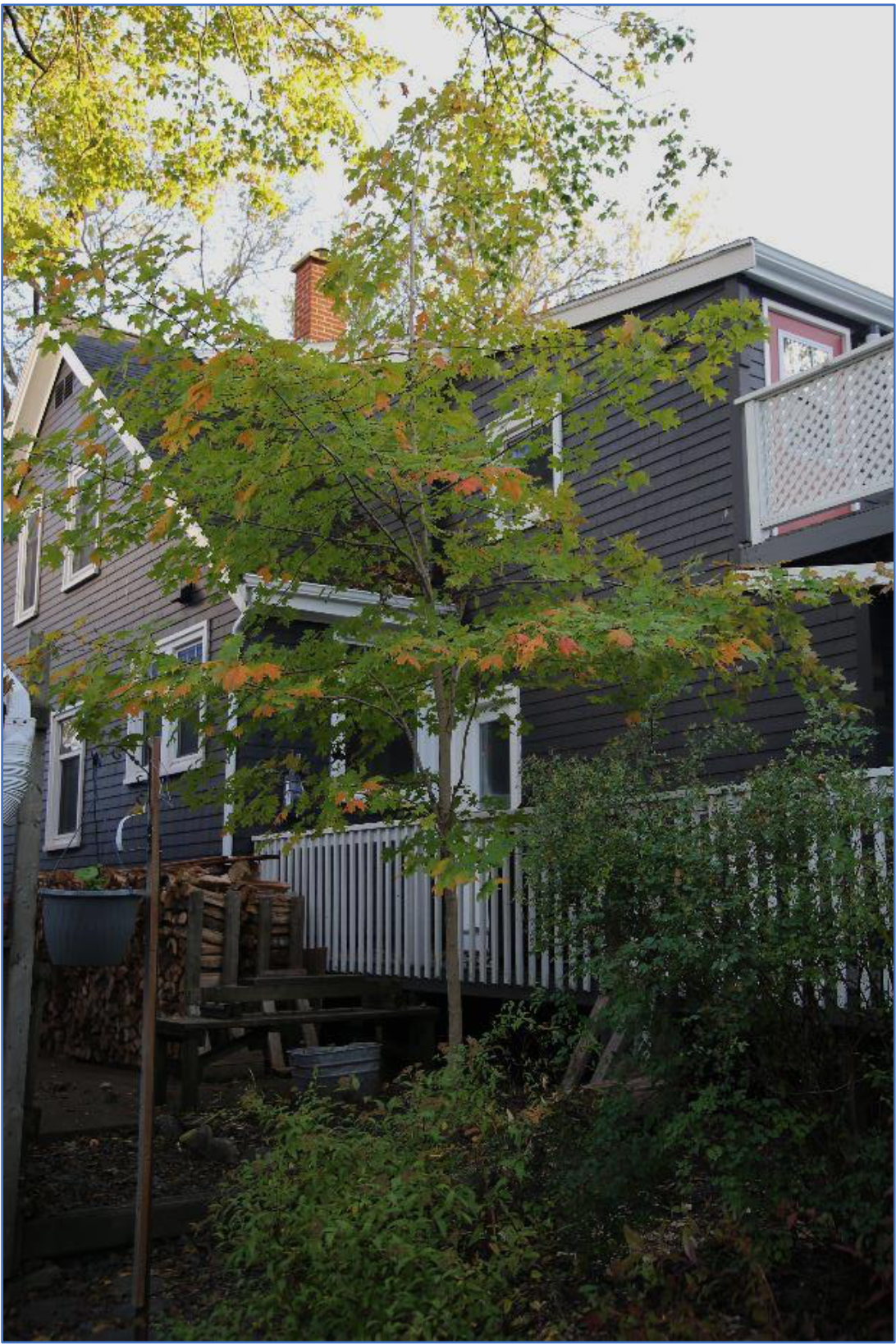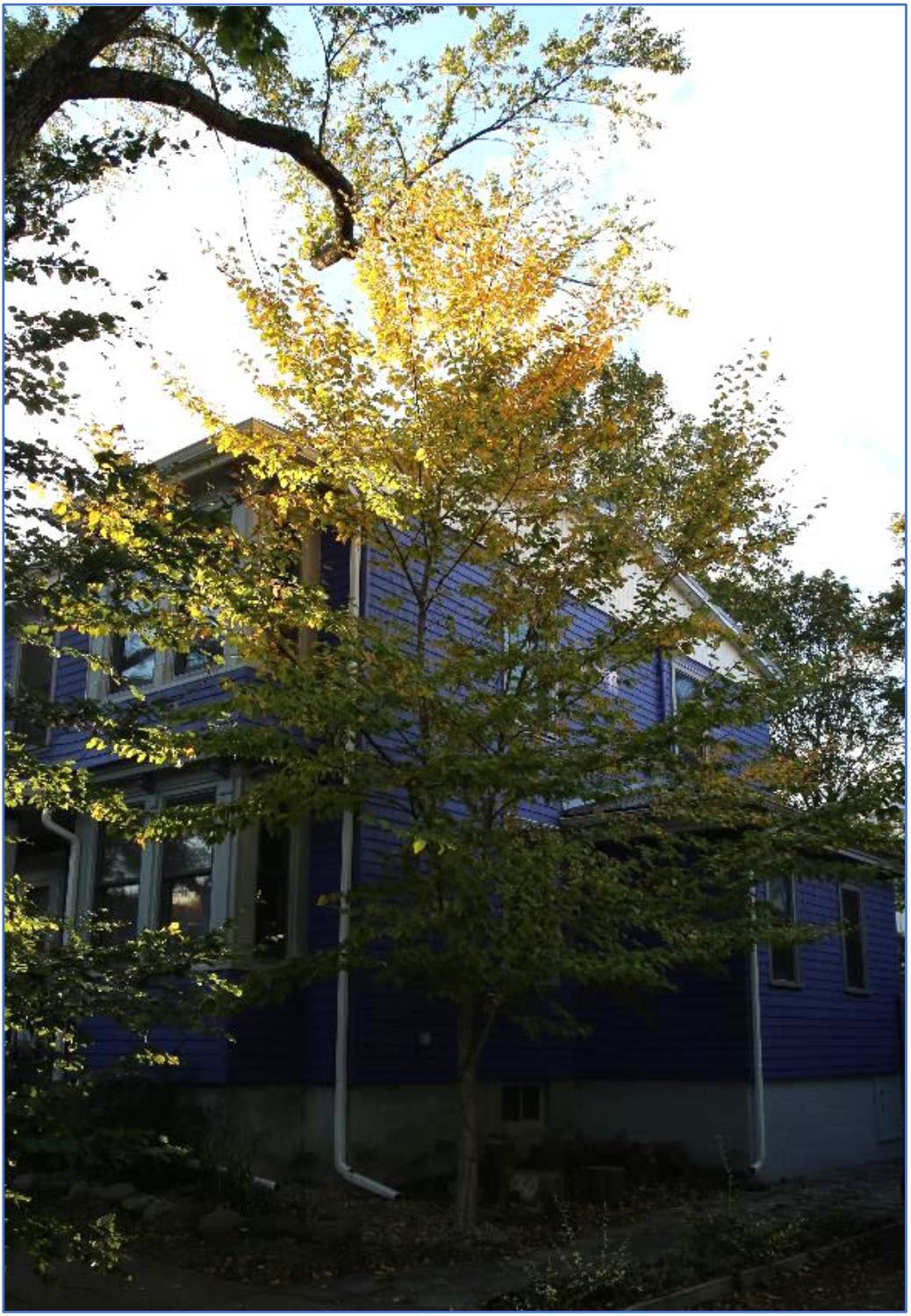At home with trees
Peter Duinker, Halifax Tree Project
October 2022
My wife Maggie and I have lived in our current home in the centre of the Halifax Peninsula for twenty years. When we took possession of the house, there was one mature elm in the tree lawn out front, one black locust sapling along the side, and five maturing Norway maples in the backyard. In this article, I describe the evolution of our tree population as I have altered it during the past two decades.
The first order of business was to remove the black locust because, being a volunteer instead of being planted where it was (I have no idea where the seed came from), it was growing so close to the house that during even a mild wind, it would bump against and damage the rain gutter on one of the house’s extensions. The second order of business was to get some young stock planted in various openings around the yard. My aim has been, right from the start, to de-commission all the Norway maples (for all the reasons listed in the article on Norway maple that you can find on the HTP website (https://www.halifaxtreeproject.com/the-norway-maple)) and establish a copse of the best old-growth native Acadian-forest tree species.
To acquire trees at the least cost (I’m of Dutch extraction and always look for a bargain!), I went out to the periphery of the city where I knew a lot of young trees were growing alongside an on-ramp to a 100- series highway. I am in no way endorsing this for other people to pursue, just stating a fact. These trees are periodically killed with a huge cutting machine to keep the road right-of-way clear of trees. I’ve heard that the main reason for doing this is so motorists can see the eyes of deer and other mammals in their headlights long before the animal might be on the roadway itself. I am not a fan of destroying so many potentially useful trees – why not find ways to safely extract them from the roadside and give them away to people who would like to plant one or more of them in their yards? On that day in June 2002, I took three small trees of the species I wanted – a red spruce, a white pine, and an eastern hemlock.
The red spruce was planted in a small low area of our yard near the public sidewalk. The white pine was planted near the property line with one of my neighbours, about lined up with the backs of our respective houses. The hemlock was planted at the back near my other neighbour’s property.
Then three more trees were planted around 2008. I was gifted these small trees from the HRM urban forester – one was a wee dug-up European beech from Point Pleasant Park, and two were mere whips left over from the huge planting projects at Point Pleasant Park – a white birch and a yellow birch. The two birches were planted out front just a metre away from the red spruce (I like planting trees close together, which is rather natural for trees in Nova Scotia), and the beech I stuck somewhere in the backyard.
The beech did not do so well for its first couple of years, so I replanted it into the tree lawn. This is another action I cannot recommend because it is contrary to the HRM bylaw that governs what property owners are allowed to do in the right-of-way that adjoins their property. My rationale for doing this was that some day, perhaps sooner or perhaps later, the big elm in front of the house will either succumb to a big wind event like Hurricane Fiona or die of other causes. It already seems to be in a slow decline. I wanted a new tree already flourishing as a sapling, or even larger, in that tree lawn for the time when the elm is finished its long life of unselfish delivery of a wide range of ecosystem services.
Finally, two trees arrived into my property as potted stock from a NS nursery in about 2012 – a sugar maple and a red oak. Here is a synopsis of how each tree is doing today. Each is wonderfully healthy. Diameter at breast height (or DBH, the diameter of the trunk measured 1.3 m from the ground) and height of the entire tree are given, where applicable. A photo of each tree (except for the Norway maples) is included. The backyard Norways are visible in the centre of the drone photo below.
The Norway Maples
There were five when we bought the house. Now there are 1.5 left. Three were removed in the past 15 years, and recently I removed one of two stems on the second to last. I did this to make room for the red oak to grow straighter because it was seeking light from under the Norway-maple canopy. I left the back half of that tree standing so the neighbours to the north would have summertime shade on their parking area. Hurricane Fiona knocked two major branches out of that tree, fortunately causing way less damage to property than could have been the case. Shortly I will remove (using a tree-removal arborist’s services) the largest Norway maple for three reasons: (a) to give the sugar maple planted under it an opportunity to grow straight up; (b) to allow more light into the backyard gardens; and (c) to reduce the load of fruits and leaves that fall onto my roof and deck. Had I no other trees in my backyard, I would probably not have been aggressive in removing the Norway maples. However, I have waited patiently for the small trees to become established and now it is prudent for me to remove more of the Norways.
The White Pine
The tree was about a metre tall when I planted it in 2002, right in a pathway that was likely a driveway for many decades after the house was built in 1922. I was amazed at the growth rates this tree displayed in such a compacted soil. It now has a DBH of 20 cm and is about 12 metres tall. Some years, the increment of height was about 80 cm. It is in great condition, having escaped the white pine weevil which destroys the terminal bud and kills the leader. However, this year, the entire leader and associated side twigs all died, I’m supposing as a response to this summer’s drought. I expect that from the living top I will now see multiple main stems – perhaps three of them – take the tree higher and higher.
The Sugar Maple
I grew up in the midst of sugar maples in southern and central Ontario and am smitten with the species. I’m so happy that it is native to Nova Scotia. The tree was purchased for about a hundred dollars from a NS nursery in about 2012 and planted at about 3 cm DBH and three metres tall. It is now seven metres tall with a DBH of about 6 cm. Miraculously, it was totally unscathed as Hurricane Fiona blew out a huge part of the neighbour’s Norway maple tree onto my backyard garden. Later this autumn, with the removal of the Norway maple overshadowing it, the sugar maple will have a free-and-clear sky above so it can straighten up and become a magnificent tree through the 21st century.
The Eastern Hemlock
Hemlock is the longest-lived tree species in NS. Recently, in the southwestern end of the province, one hemlock was measured at over five hundred years. Hemlock is an iconic old-growth species here. I planted mine in 2002 when it was about 60 cm tall. It just sat there for 15 years, hardly growing at all but hanging in with good health – it was overtopped by some kind of berry tree. With my neighbour’s consent, I removed the berry tree (I don’t know the species and, frankly, didn’t care) to bring more light to the garden and remove the competition – both above- and belowground – from the hemlock. Immediate results! The hemlock took off five years ago and is now 2.5 metres tall with a DBH at about 1.5 cm. I hope that the species’ relative rarity in the city will make it impossible for the hemlock woolly adelgid, now ravaging the hemlock populations of southwestern NS, to find it!
The Red Oak
Like the sugar maple, it came as a potted sapling from the same nursery. I planted it in the shadow of a Norway maple, fully expecting that, in due course, I would have the Norway taken down. The tree was planted in what was a compost heap. Needless to say, it is growing very well, especially now that it has less Norway-maple foliage above it. Its dimensions are eight metres tall and 7 cm DBH.
The Yellow Birch
I can’t remember which birch – the white or the yellow – was 50 cm tall and which was 80 cm tall when they arrived at my porch. Doesn’t matter now. The yellow birch has been in the ground for 14 growing seasons and stands 12 m tall (above the second-story gutters) and has a DBH of 12.5 cm. Its neighbours the white birch and the red spruce were taken down two years ago – the white birch was leaning far too much for comfort over the neighbour’s parking spaces and the red spruce did not flourish at all under the birch canopies. The yellow birch has two stems starting about three metres above the ground. I was advised by arborist friends that I should have removed one of the stems so that it would continue vertically with one leader. That is the arboricultural standard for amenity trees (except perhaps for elm with refuses to grow with just one leader). I’m trusting that yellow birch has strong connections between major branches of the stem – I do know that the wood itself is dense and strong. It is among the best species for wood flooring and firewood (I use it for both!).
The European Beech
I recall it being scrawny and shrubby, almost pathetic in its size and form, when I planted it around 2010. The twists in the lower stem even today betray its laboured beginnings in a heather patch in Point Pleasant Park. It is now a proud member of the street-tree population standing some ten metres tall with a DBH of 8.5 cm. The tree requires constant pruning so that its lower branches do not impede foot traffic on the sidewalk nor parked cars in the street. It is not yet suffering from beech leaf-mining weevil which is evident in many of the mature European beeches around the city, particularly those in Point Pleasant Park. By the way, the European beeches in the Park are reproducing prolifically, especially on the south side of Heather Way. In the woods you can see numerous specimens of European beech successfully competing with the native tree species there.
Here are a few observations and conclusions I’ve come to in the past two decades about trees in a small city-centre residential property.
Most trees in our Peninsula backyards are volunteers arising from errant seed from street trees and managing to escape the lawn mower in their first years. That’s how I got so many Norway maples in my backyard – they are prolific competitors and therefore deemed invasive.
Transitioning a tree canopy from unwanted species to desirable ones does not have to occur by creating a mini-clearcut and starting over again. I have successfully reared some competition- tolerant young trees of native species while the overstory of Norway maples is gradually being removed.
Instant gratification never works when growing new trees, unless you are like me and adore even the smallest trees. From seed or seedling to sapling to maturing trees takes a few decades at least. However, one’s appreciation of the trees, just like that of raising an animal pet, can begin rather early in the organisms’ lives.
Getting good trees established on one’s property does not need to be expensive. I paid for two of my six trees, the others coming to me free of charge. Granted, I have contacts and networks, even boldness, that garner me free trees. The smaller the tree to be planted on your property, the less expensive it will be if you pay for it at a nursery. Plus, the smaller the tree, in all probability, the better its rooting system will ultimately be. Indeed, in some years the small tree would probably catch up in stature to the same species planted larger.
Planting a tree correctly is easy; planting it incorrectly is easier still. There is an abundance of guidance online on how to do it right. One might start here: https://static1.squarespace.com/static/5b3babac70e802454aede034/t/5b69df326d2a73dcca4b a0e7/1533665079612/Hayden_etal_2016_TreePlantingTips%26Tricks.pdf
Watering newly planted trees is absolutely essential to reduce the stress of planting when rainfall is inadequate to support root development. I don’t recall ever watering my trees during their establishment years, but neither do I recall debilitating summer droughts when I planted them. This summer of 2022, we had serious drought conditions. The new trees my research team and I planted on Lawrence St. in June (see the Lawrence St. tab at https://www.halifaxtreeproject.com/lawrence-st) needed lots of water through to late September – I watered each of them 14 times with at least 15 L each time.
In conclusion, I wish I had had the opportunity to own land from my early adulthood so I could live with the trees I planted for my entire adult life. But I will not lament this situation and rather I’ll be glad and thankful, daily, for the opportunity to have spent the last twenty years nurturing a small copse of Acadian long-lived tree species (save for the European beech, of course – long-lived and strong but not Acadian!) on the postage stamp of property I share with Maggie in Halifax.






